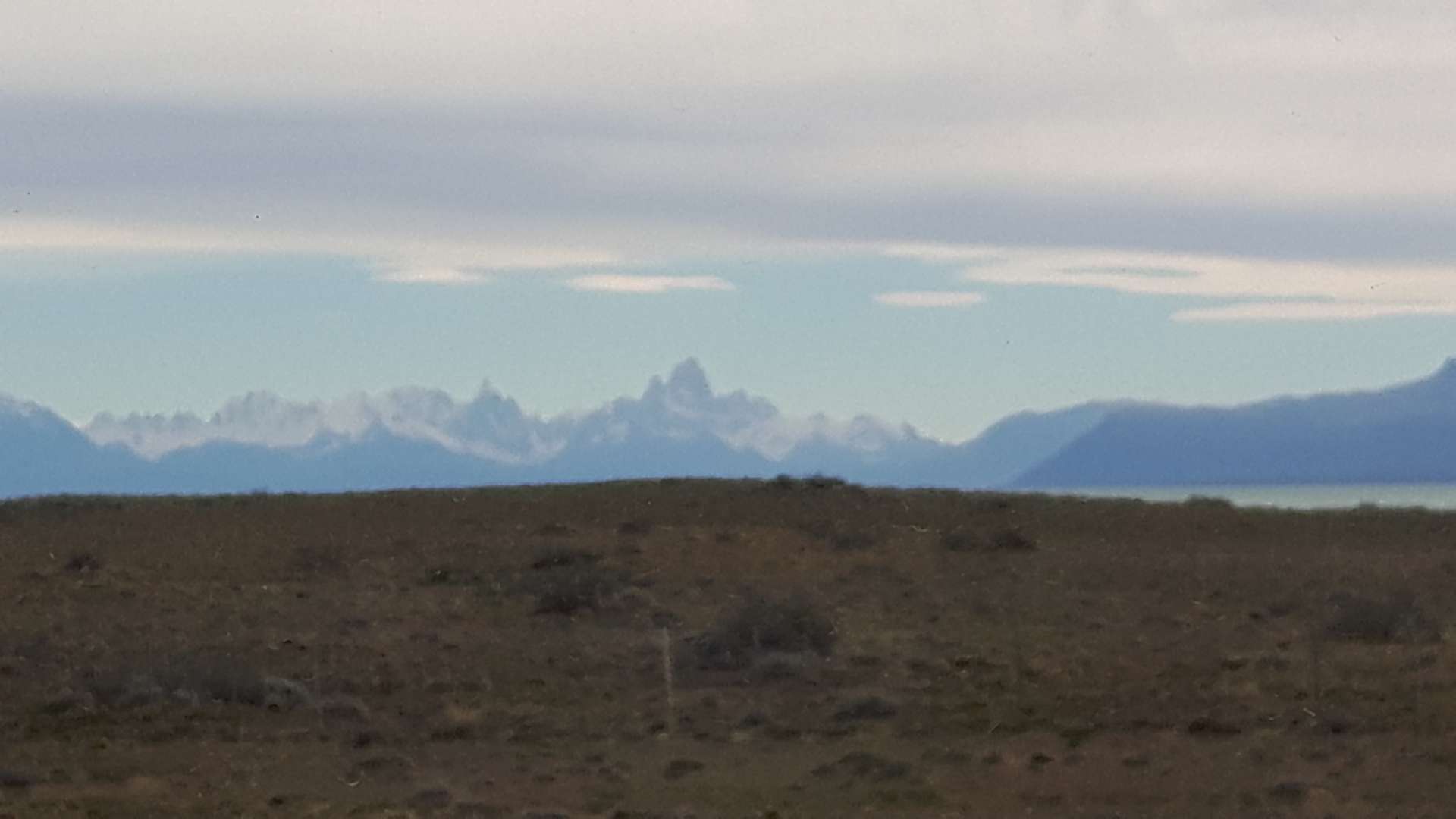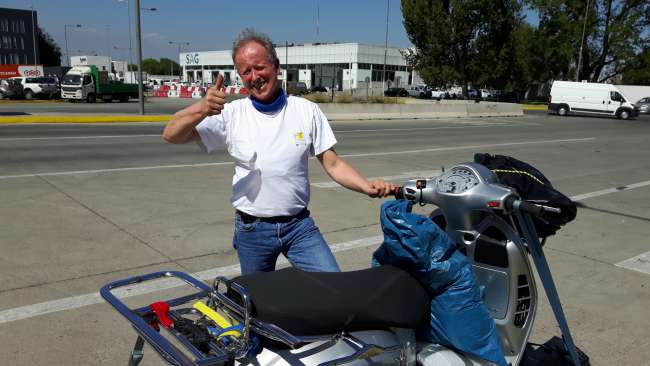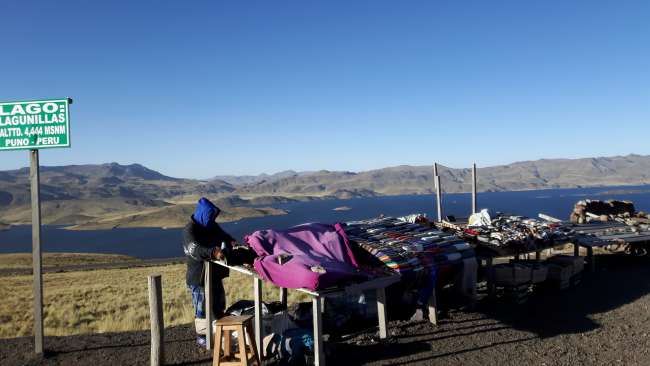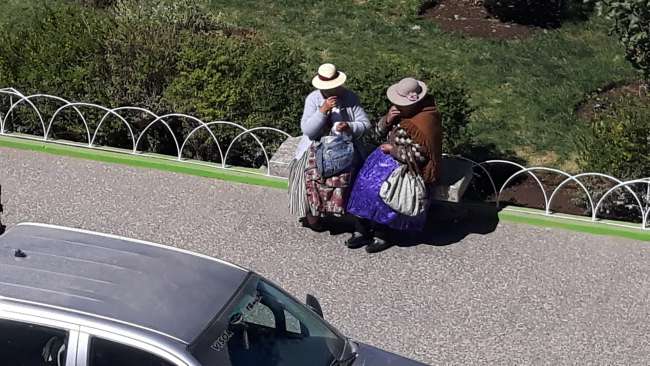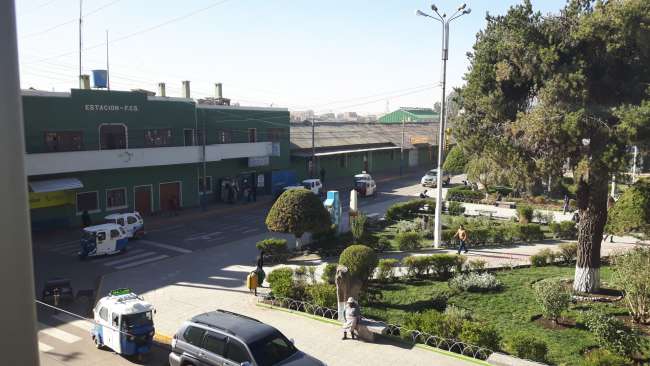ab 12.06.: Juliaca - the forbidden city - 3,800 m
شائع شدہ: 14.06.2017
خبری مکتوب کے لیے درخواست دیں
12.06.:
thanks to my hostelfather in Arequipa, I should be spared a challenging day today.
My plan is to ride to Cusco via Espinar with an overnight break and stay there for a few days.
But he advises against it and says that the road is not paved, only a few sections are, but he wouldn't ride there with a Vespa.
We look at the road map and he recommends me to go through Juliaca. It's only half an hour from there to Lake Titicaca.
here is no alternative for me. Ross, my hostelfather in Arica strongly advised me against staying there. Only drive through during daylight. He is not a timid person who sees robbers everywhere, but in this case I understood his warning and crossed out the city on the map.
With a slightly uneasy feeling, I start riding, also because he warns me about fog and snow at an altitude of 4,200 m.
Well, I think to myself, then there will be three premieres today: snow, fog, and altitude. But I won't let that deter me. I'm well fortified by the breakfast I had again in the market halls today and it can't be that bad. The sky is cloudless, I don't see any feather clouds to the east either, so let's go.
I spend an hour and a half in the traffic chaos of Arequipa.
Pure madness!
It's about 10:00 am, the rush hour should be over by now - but it's still crazy here. It wouldn't be so bad if there were separate lanes for taxis and buses. But they stop on the right lane without signaling and the pushing starts. The cars behind the bus, which can't plan ahead because the bus driver doesn't signal, start to blink, but only at the moment when the left fender almost touches the right fender of the car driving on the left lane. These maneuvers are accompanied by piercing honking, imitation siren wailing, which only the police are entitled to, stop signs, which have the same meaning as ours, are ignored, waiting mothers with their children are ignored at pedestrian crossings, motorcyclists who don't stay in the middle of their lane are honked at and pushed away.
A tough Berlin taxi driver could dismiss all of this as folklore. But when steep roads are added, which are used by overloaded and black-smoking trucks driving at 20 or 30 km/h, the patience limit is reached even for these taxi drivers.
These climbs are long and on both sides there are not wide sidewalks, but wide dust tracks that are used by both pedestrians and trucks for loading and unloading. Almost impenetrable dust clouds cover the road, and there is also a traffic light system that drives you crazy. Starting uphill on a steep mountain, the clutch suffers, then drive 3 meters because cars overtaking buses cut in, then red again.
I spend some time behind an army truck and watch an ice cream vendor who scents the business of the day - the traffic light is red, the army truck is filled with many ice cream-hungry privates. The negotiations are finished more or less on the run - red again, now it's time to complete the deal, the hand with the goods is already raised, in that moment the driver accelerates, the vendor sprints after him, hoping that the traffic light will turn red again... It doesn't. He accepts it and prepares for the next business.
Finally, the traffic thins out, the air gets better, the traffic lights become fewer, and driving becomes almost trouble-free. Although it's well-meaning and has surely earned the deputy who campaigned for it many votes from mothers with children - but for the driver, it's tyranny. Without warning, maybe a sign that is covered by a truck, a nice and high bump appears on the road, which should warn the drivers that a pedestrian crossing is to be expected a little later and that they should reduce their speed. Speed? I ask myself. Here, there's only stop and go... In addition, there are grooves cut across the road, which serve the same purpose and are gladly used on country roads to facilitate the crossing of either cars or pedestrians. Well - maybe that's justified here.
The Vespa takes it all calmly. Starting uphill, fully loaded as we are, then stopping again, and repeating that many, many times. But then we can pick up speed, leave the stinking trucks behind us, and speed up the mountains at 80 km/h. The mountains ahead of us are not sand dunes, but covered with tufts of grass. It's fertile here, we drive over bridges under which Andean water flows, it slowly gets colder, but pleasant because in the city, it was a stinking sauna.
The second jet op is coming up. Meanwhile, we are at 3,600 meters. I find a parking bay and after a short time, we continue.
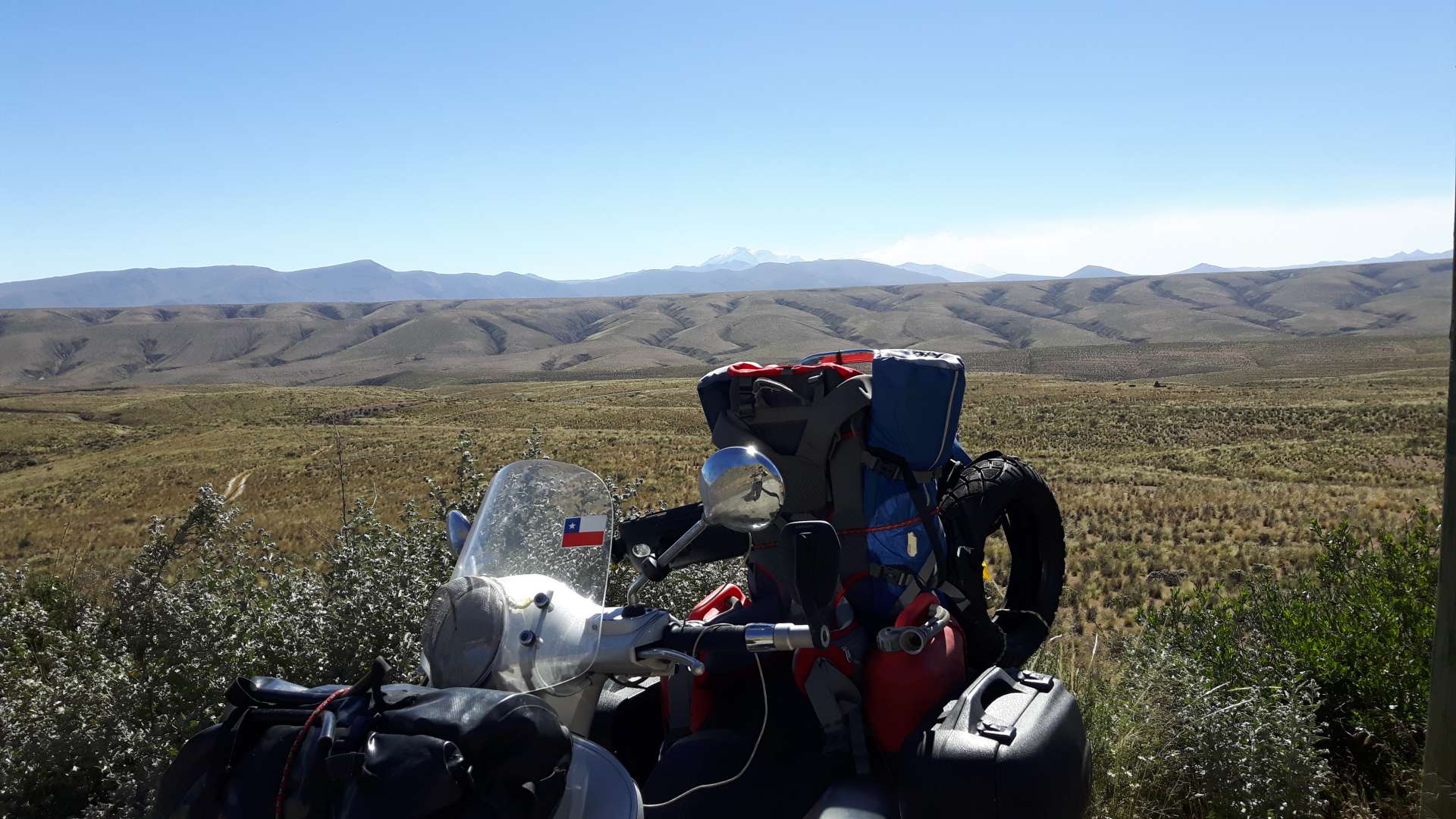
The second jet op at 3,600 m
no more sand dunes, only green tufts of grass, vicunas and alpacas crossing the road - calm and leisurely. They are hardly visible from a distance. Fur and landscape blend together. Another danger point...
Quickly take a few photos, but that's all. There is no accommodation between Arequipa and Juliaca. And even though Google Maps says it's a 5-hour drive for 280 km here, it will be at least 7 hours for me. I have a long ride ahead of me. The jet adjustment gives me more momentum, overtaking slow trucks that later on take advantage of gravity and race past me at 120 km/h on downhill and winding roads. They are playing with their fate and many crosses by the roadside show me that many have lost this game. It was more enjoyable to drive on Chile's roads. Here, I have to be prepared for the new asphalt surface, potholes, bumps, and sandy spots. Later, I see a long-distance bus from a distance - either it broke down or is admiring alpacas. Broken down. The co-driver asks me to stop and I don't know if that's a good idea. But it's already too late... until I realize that he wants gasoline from me for his motor that went down on its knees, some scenes from Räuber Hotzenplotz play in my head. I gladly give him gasoline - as much as he wants! But he is satisfied with 3 liters, and I continue driving, proud that a little David could help the big Goliath.
We keep climbing the mountain on two-lane roads, clear air, and I'm sure we have already reached an altitude of 4,200 meters. We're close to it and luckily, we have a tailwind. When my altimeter shows that we have crossed the 4,200 m limit, there is a short chorus of honking as praise for the Vespa. And the horizons expand for me: Then I will definitely be able to cross the Andes to Brazil or Argentina - if there is no snow - and I don't have to go back to Santiago to cross the Andes on the way to Mendoza!
No sign of fog or snow!

This is the current record: 4,444 m above sea level
We are on the Altiplano plateau accompanied by the Lagunillas with flamingos
Despite all the joy, I realize with horror that the shadows are getting longer and it's getting cold, so cold that I turn on the heated grips. I should actually pull over and dress warmer, but I let myself be chased. We pass many blue lagoons - we are now on the Altiplano, a drainageless plateau that extends from southeastern Peru to western Bolivia and stretches between the West and East Andes - and I can observe flamingos enjoying themselves in the salt lakes.
I only stop once more to take photos, not least because we have a nice three-digit number to celebrate:
4,444 meters above sea level!
At another point, I put on warmer clothes and then we go in the final sprint on long stretches with a tailwind to Juliaca. We have now settled at 3,800 m, the wind is getting stronger, the climate harsher, and the view into the plateau becomes even more beautiful.
I arrive in Juliaca, it's already a bit twilight, but Peruvian drivers only turn on their lights when it's dark. We come to a police checkpoint. Another local motorcyclist and I are waved over. I am not further inspected - probably because I am German - but I use the safety terrain to look for a hostel on my GPS. I am standing not far from a slightly larger sand hole, in front of which the police have cleverly set up the checkpoint. In the short time I stay there, two cars bury their right front wheels in it. The second time, I can't help but laugh, and even the policeman - a comfortable, quite weighty official - can only be amused by the recklessness of the drivers... they must know that there are bumps and sandy holes here..., his expression tells me.
And now comes the real final sprint: darkness, dim street lights, dusty roads with potholes, and drivers who I only recognize at the last moment because their low beams are not switched on. I drive rather hesitantly, which annoys the local drivers.
The lady from the GPS is sometimes overwhelmed because the route has changed. I'm supposed to turn right and then left, right again after 100 m - but she leads me to the darkest corners of this city. The roads are one constant up and down, and then as the crowning glory comes a really steep stretch of road - paved - on which the Vespa almost wants to give up the ghost. Before that, there was a red traffic light, I just have enough momentum to overcome this slope.
Finally, we arrive in the city center. The plaza and the church are in front of me, but my hostel??? Then I notice a hotel, the hostel is forgotten, I check in, the Vespa goes into the garage, and finally, work is done. 7:00 pm!
13.06.
3,800 m are not easy to handle. Or is it because of yesterday's tour? I live in a large room here with a window front facing the Plaza de Bolognesi - also a saltpeter fighter - but it was as cold as a refrigerator here yesterday. But there is a radiator here that slowly warms up the room. It's on wheels and while I'm writing, it radiates pleasant warmth. The hotel guests appear for breakfast in thick jackets. From the lounge where breakfast is served, there is another door leading to the hotel garage, which is often left open. Winter is not taken seriously in South America. There is enough opportunity to warm up in the sun during the day. And it's reliable. Every day anew, every day a cloudless sky.
The head is throbbing, every movement is accompanied by a lot, very much oxygen intake - there is not so much up here, so I sometimes feel like a fish out of water.
If I were fit, I would avoid Juliaca. Even my hostelfather in Arequipa advised me against visiting this city. The forbidden city?
So I observe life - like grandma without a cushion on the windowsill - the hustle and bustle on the plaza and amuse myself about the three-wheeled motos driving on three lanes. Otherwise, I see many kids walking hand in hand with their grandmothers or running away from them, I see women with the typical broad-brimmed hats and a large blanket transformed into a sack, decorated in Peruvian colors, which either houses a baby or goods that need to be taken to one of the numerous stalls.

Having their morning chat
I also observe bicycle taxis used by locals. Tourists don't really get lost here because the bus passes Juliaca on the way to Puno. The city, with its population of around 220,000, located on the Altiplano, lives off the textile industry and is also called 'Ciudad de los vientos' (City of the Winds). I was able to experience that quite a bit when I arrived here yesterday.

Racing each other for 2 soles - €0.55 - per ride. Four-wheeled ones cost €1.10
Suddenly, a rough knocking on my room door brings me back to my own life. I am asked to move the Vespa, which is parked between two cars with permission, out for a moment. It doesn't start, which is something new for her, and with the combined effort of the two receptionists, we push it back in after the cars are outside again. I'm not worried about it not starting. I top up the fuel, as I drove the tank almost empty yesterday, and go back upstairs - quite out of breath - like an old man!
Most of the rest of the day consists of sleeping, accompanied by the promotions people from the internet provider claro, who is currently running a very aggressive publicity campaign. Even during my ride through the mountains, the company took the trouble to use large white stones to drape its logo in large letters on the sand dune. Easily visible from afar.
Hunger drives me out into the windy cold and that's the end of the day for me.
14.06.
Two things are on the agenda: getting the Vespa going and finally organizing liability insurance for Peru and the neighboring countries. A similarly difficult task as at the beginning of my journey in Santiago de Chile.
Today, my strength has returned a bit more, but the headache remains. I'm not worried about it. It's part of being at such a high altitude and it will resolve itself after a few days.
Before I deal with the Vespa, I check the corresponding forums. My suspicion is that the fuel pump has given up. That would be very annoying. Maybe a clever mechanic could have repaired it - I could have had it sent to me from Lima - if it was in stock - but trying to get one from Germany would have been the last resort, because I'm currently experiencing that even three weeks is not enough in this case. But that's due to the Chilean border officials who are probably on strike again.
To get clarity, I disconnect the fuel hose, let the Vespa turn over, and hurray, the fuel runs over my hands, the sound of the working pump is back. I do the same procedure with the carburetor intake, and here too, the red liquid comes out vigorously from the hose. Great relief!! The spark plug is more or less a tan color, and it produces a spark.
I inform Wilfried, my 'workshop coach', via WhatsApp about each of my steps, and in the afternoon - it's 10:00 pm in Germany - we exchange voice messages. Technology makes it possible: Wilfried is sitting in Hamme and I'm in distant Peru.
But the Vespa doesn't care about that, it turns over and over again, but the engine doesn't start. Hmm, I think - I'm stuck in Juliaca...
15.06.
In the night, I have a brainwave! There is a platform for independent travelers with four or two wheels, where a hostel and a shelter for the vehicle are offered. So there will also be motorcyclists staying there, and it can be expected that they will surely be looking for a good workshop from time to time. My plan: to take a mototaxi and visit the three hostels here in Juliaca and ask the receptionists about a workshop. Because I don't want to repeat an experience like in Calama.
The taxi driver in his green and white moto-taxi understands what I want. We drive in the direction indicated by Google Nav, but after 10 minutes, we realize that the given address is wrong. Before we drive to the other two addresses, I have another idea: the taxi driver should take me to his workshop because his Vespa-like vehicle - only with a sidecar - also needs reliable maintenance. I explain this to him and use the term - good! workshop with emphasis. He starts to enjoy the challenge. There is one problem to solve. The mechanic has to get into the taxi and come with us to the hotel and diagnose there...
His mechanic waves it off - I still show him a nice photo to establish a relationship between the object and the person, but he is alone and can't leave. The taxi driver is now 'hooked' and has his eye on someone else. We drive there. He is also initially reserved, but showing him the photo of the Vespa and telling him my story has an effect. He actually gets out of the mini taxi equipped with heavy tools. On-site, he talks about cleaning the carburetor, which doesn't convince me, but after a few attempts, he manages to start the Vespa. He suggests driving the Vespa to his workshop and I follow him in the taxi. There is no time for suspicion now, and I don't entertain thoughts like 'what if...' in the subjunctive. We set off. The road conditions are a disaster. The side streets are just dirt roads with large sand holes or obstructions. How did people get by here when the storms raged in the spring and almost all of South America's north was flooded? The roads were one big mud fight... But the traders still have to move forward with their fully loaded bicycles. Because money has to be earned - one way or another. No one takes that into consideration.
We bump along - on the asphalt - if there is one - my special friends in the form of bumps appear again, then there are rain gutters inset at intersections that also require driving slowly - I admire the tricycle that must not tip over during these maneuvers... the Vespa is no longer visible, but I remain calm. A little later, we are back at his workshop. He takes the carburetor out, doesn't know the cooling system, pulls hoses before I can make myself understood, and the hot liquid pours over his hand... he is brave, takes out the carburetor, and I show him the modified nozzle. That must be the reason, he suspects, gives the taxi driver an address, and we set off. We have to find or get a smaller nozzle here. We inquire at three workshops and finally find the coveted object. We install it, and the Vespa starts. Fabio, that's the mechanic's name, his teenage daughter, who watched our undertaking with a hidden grin, is named Karin - a funny name for this region - initially hesitates and then agrees to 30 soles. That's €10. My taxi driver gets 50 - that's very generously rounded up. Fabio notices that - I do too - and I also round up accordingly with Fabio. He doesn't understand that, and I say, everything has to be fair. The right word doesn't come to mind, and I show a balance... he is happy, and the situation relaxes again.
In the evening and late at night, I start the Vespa - it's hesitant, but then it's there.
The insurance is also arranged. The journey can continue.
خبری مکتوب کے لیے درخواست دیں
جواب دیں۔

سفری رپورٹس پیرو
